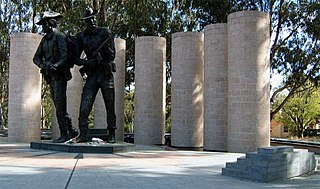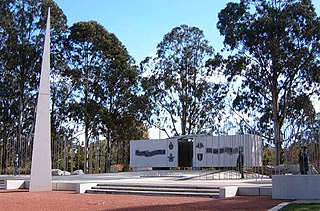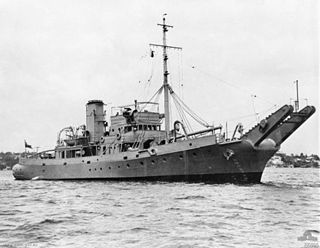
HMAS AE2 was an E-class submarine of the Royal Australian Navy (RAN). One of two submarines ordered for the fledgling navy, AE2 was built by Vickers Armstrong in England and was commissioned into the RAN in 1914. Together with her sister submarine, HMAS AE1, the boat then sailed to Australia in what was, at the time, the longest voyage ever undertaken by a submarine.

The Anzac class is a ship class of ten frigates; eight operated by the Royal Australian Navy (RAN) and two operated by the Royal New Zealand Navy (RNZN). During the 1980s, the RAN began plans to replace the River-class destroyer escorts with a mid-capability patrol frigate and settled on the idea of modifying a proven German design for Australian conditions. Around the same time, the RNZN was seeking to replace their Leander-class frigates while maintaining blue-water capabilities. A souring of relations between New Zealand and the United States of America in relation to New Zealand's nuclear-free zone and the ANZUS security treaty prompted New Zealand to seek improved ties with other nations, particularly Australia. As both nations were seeking warships of similar capabilities, the decision was made in 1987 to collaborate on their acquisition. The project name is taken from the Australian and New Zealand Army Corps of the First World War.

HMAS Stuart is an Anzac-class frigate of the Royal Australian Navy (RAN). She was built at Williamstown in Victoria, and commissioned into the RAN in 2002. The frigate is operational as of 2021.

HMAS Sydney was a Chatham-class light cruiser of the Royal Australian Navy (RAN). Laid down in 1911 and launched in 1912, the cruiser was commissioned into the RAN in 1913.

HMAS Australia was one of three Indefatigable-class battlecruisers built for the defence of the British Empire. Ordered by the Australian government in 1909, she was launched in 1911, and commissioned as flagship of the fledgling Royal Australian Navy (RAN) in 1913. Australia was the only capital ship ever to serve in the RAN.

HMAS Anzac is the lead ship of the Anzac-class frigates in use with the Royal Australian Navy (RAN) and the Royal New Zealand Navy (RNZN). Entering Australian service in 1996, the frigate operated as part of the INTERFET peacekeeping taskforce in 1999. In 2003, she was involved in the Battle of Al Faw, and became the first RAN ship to fire in anger since the Vietnam War.

HMAS Anzac was a Parker-class destroyer leader that served in the Royal Navy and the Royal Australian Navy (RAN). Launched in early 1917 and commissioned into the Royal Navy, Anzac led the 14th Destroyer Flotilla of the Grand Fleet during the First World War. In 1919, she and five other destroyers were transferred to the RAN, with Anzac commissioning as an Australian warship in 1920. Except for three visits to New Guinea and one to the Solomon Islands, Anzac remained in southern and eastern Australian waters for her entire career. The destroyer was decommissioned in 1931, sold for scrapping four years later, stripped for parts, then towed outside Sydney Heads and sunk as a target ship in 1936.

HMAS Arunta is an Anzac-class frigate of the Royal Australian Navy (RAN). The ship, named for the Arrernte people, was laid down in 1995 and commissioned in 1998. Since entering service, Arunta has performed a wide range of duties, including border protection patrols in northern Australian waters, and several deployments to the Persian Gulf.

HMAS Perth is an Anzac-class frigate of the Royal Australian Navy (RAN). The last ship of the class to be completed, she was built by Tenix Defence and commissioned into the RAN in 2006. In 2007, Perth became the first major warship of the RAN to be commanded by a woman. During 2010 and 2011, the frigate was used as the testbed for a major upgrade to the Anzac class' ability to defend themselves from anti-ship missiles.

HMAS Ballarat is an Anzac-class frigate of the Royal Australian Navy (RAN). The frigate was laid down in 2000 and commissioned into the RAN in mid-2004. Since entering service, Ballarat has been involved in border protection as part of Operation Relex II, was deployed to the Gulf for Operation Catalyst, and was one of the two ships involved in the Operation Northern Trident 2009 round-the-world voyage. Ballarat has undergone the Anti-Ship Missile Defence (ASMD) upgrade, completing in 2015.

HMAS Canberra (I33/D33), named after the Australian capital city of Canberra, was a Royal Australian Navy (RAN) heavy cruiser of the Kent sub-class of County-class cruisers. Constructed in Scotland during the mid-1920s, the ship was commissioned in 1928, and spent the first part of her career primarily operating in Australian waters, with some deployments to the China Station.

The Australian Vietnam Forces National Memorial is on Anzac Parade, the principal ceremonial and memorial avenue in Canberra, the capital city of Australia. The memorial was dedicated on 3 October 1992. It commemorates the 50,000 Australian Army, Royal Australian Navy, and Royal Australian Air Force and associated personnel who served in Vietnam during the Vietnam War.

The Australian Army Memorial on Anzac Parade commemorates the service of Australian soldiers.

The Hellenic (Greek) Memorial is on Anzac Parade, beside the Australian War Memorial in Canberra, the national capital city of Australia.

The Australian Service Nurses National Memorial is on Anzac Parade, the principal ceremonial and memorial avenue of Canberra, the capital city of Australia.

The Australian National Korean War Memorial is on Anzac Parade, the principal ceremonial and memorial avenue in Canberra, the national capital city of Australia.

TSS Kanowna, was an Australian steamer built during 1902. The 6,993-ton, 126-metre (413 ft) long Kanowna was constructed by William Denny and Brothers of Dumbarton, Scotland, and had a twin screw design.

The history of the Royal Australian Navy traces the development of the Royal Australian Navy (RAN) from the colonisation of Australia by the British in 1788. Until 1859, vessels of the Royal Navy made frequent trips to the new colonies. In 1859, the Australia Squadron was formed as a separate squadron and remained in Australia until 1913. Until Federation, five of the six Australian colonies operated their own colonial naval force, which formed on 1 March 1901 the Australian Navy's (AN) Commonwealth Naval Force which received Royal patronage in July 1911 and was from that time referred to as Royal Australian Navy (RAN). On 4 October 1913 the new replacement fleet for the foundation fleet of 1901 steamed through Sydney Heads for the first time.

HMAS Karangi was a Kangaroo-class boom defence vessel operated by the Royal Australian Navy (RAN) during World War II. The third of three ships constructed by the Cockatoo Docks and Engineering Company at Cockatoo Island Dockyard based on the British Bar-class, Karangi was launched on 16 August 1941. After the war, the ship remained in active service with the RAN and played a small but key role in the British nuclear testing program. She was placed in reserve in 1953. In 1955, Karangi was reactivated and served for another two years until May 1957 and was eventually sold for scrap in 1966.

HMAS Sydney I – SMS Emden Memorial is a heritage-listed former foreign naval ship gun and now war memorial and war trophy located in Hyde Park, on the corner of Liverpool and College Streets in the Sydney central business district, in the City of Sydney local government area of New South Wales, Australia. It was designed by City of Sydney and built from 1917 by Messrs Loveridge and Hudson, Redfern. It is also known as HMAS Sydney 1 - SMS Emden Memorial and Emden Gun. The property is owned by City of Sydney. It was added to the New South Wales State Heritage Register on 27 February 2015.




















